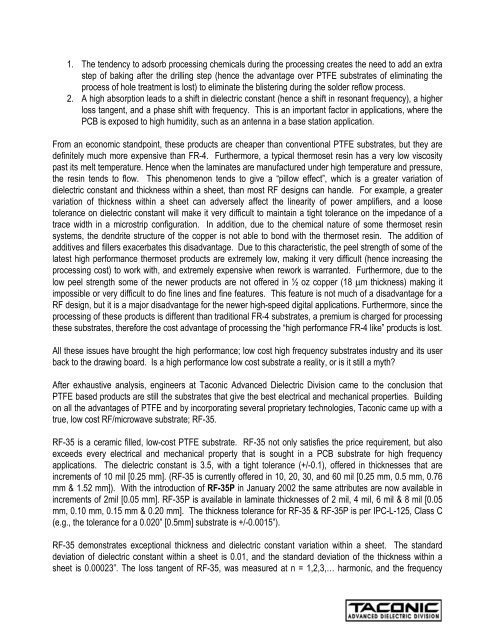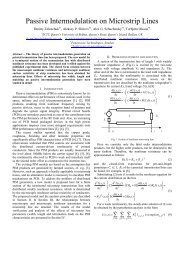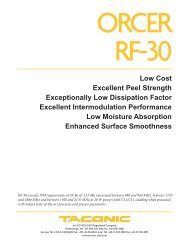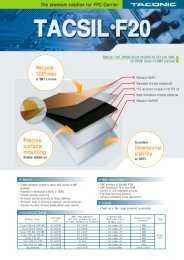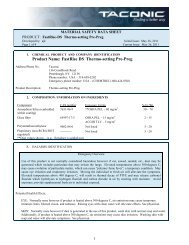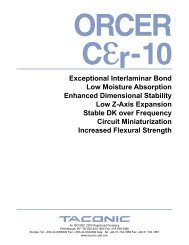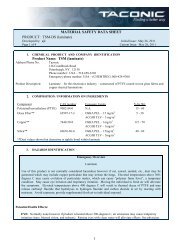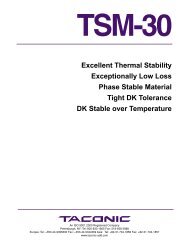High Performance, Economical Substrates: Myth or Reality - Taconic
High Performance, Economical Substrates: Myth or Reality - Taconic
High Performance, Economical Substrates: Myth or Reality - Taconic
You also want an ePaper? Increase the reach of your titles
YUMPU automatically turns print PDFs into web optimized ePapers that Google loves.
1. The tendency to ads<strong>or</strong>b processing chemicals during the processing creates the need to add an extra<br />
step of baking after the drilling step (hence the advantage over PTFE substrates of eliminating the<br />
process of hole treatment is lost) to eliminate the blistering during the solder reflow process.<br />
2. A high abs<strong>or</strong>ption leads to a shift in dielectric constant (hence a shift in resonant frequency), a higher<br />
loss tangent, and a phase shift with frequency. This is an imp<strong>or</strong>tant fact<strong>or</strong> in applications, where the<br />
PCB is exposed to high humidity, such as an antenna in a base station application.<br />
From an economic standpoint, these products are cheaper than conventional PTFE substrates, but they are<br />
definitely much m<strong>or</strong>e expensive than FR-4. Furtherm<strong>or</strong>e, a typical thermoset resin has a very low viscosity<br />
past its melt temperature. Hence when the laminates are manufactured under high temperature and pressure,<br />
the resin tends to flow. This phenomenon tends to give a “pillow effect”, which is a greater variation of<br />
dielectric constant and thickness within a sheet, than most RF designs can handle. F<strong>or</strong> example, a greater<br />
variation of thickness within a sheet can adversely affect the linearity of power amplifiers, and a loose<br />
tolerance on dielectric constant will make it very difficult to maintain a tight tolerance on the impedance of a<br />
trace width in a microstrip configuration. In addition, due to the chemical nature of some thermoset resin<br />
systems, the dendrite structure of the copper is not able to bond with the thermoset resin. The addition of<br />
additives and fillers exacerbates this disadvantage. Due to this characteristic, the peel strength of some of the<br />
latest high perf<strong>or</strong>mance thermoset products are extremely low, making it very difficult (hence increasing the<br />
processing cost) to w<strong>or</strong>k with, and extremely expensive when rew<strong>or</strong>k is warranted. Furtherm<strong>or</strong>e, due to the<br />
low peel strength some of the newer products are not offered in ½ oz copper (18 µm thickness) making it<br />
impossible <strong>or</strong> very difficult to do fine lines and fine features. This feature is not much of a disadvantage f<strong>or</strong> a<br />
RF design, but it is a maj<strong>or</strong> disadvantage f<strong>or</strong> the newer high-speed digital applications. Furtherm<strong>or</strong>e, since the<br />
processing of these products is different than traditional FR-4 substrates, a premium is charged f<strong>or</strong> processing<br />
these substrates, theref<strong>or</strong>e the cost advantage of processing the “high perf<strong>or</strong>mance FR-4 like” products is lost.<br />
All these issues have brought the high perf<strong>or</strong>mance; low cost high frequency substrates industry and its user<br />
back to the drawing board. Is a high perf<strong>or</strong>mance low cost substrate a reality, <strong>or</strong> is it still a myth?<br />
After exhaustive analysis, engineers at <strong>Taconic</strong> Advanced Dielectric Division came to the conclusion that<br />
PTFE based products are still the substrates that give the best electrical and mechanical properties. Building<br />
on all the advantages of PTFE and by inc<strong>or</strong>p<strong>or</strong>ating several proprietary technologies, <strong>Taconic</strong> came up with a<br />
true, low cost RF/microwave substrate; RF-35.<br />
RF-35 is a ceramic filled, low-cost PTFE substrate. RF-35 not only satisfies the price requirement, but also<br />
exceeds every electrical and mechanical property that is sought in a PCB substrate f<strong>or</strong> high frequency<br />
applications. The dielectric constant is 3.5, with a tight tolerance (+/-0.1), offered in thicknesses that are<br />
increments of 10 mil [0.25 mm]. (RF-35 is currently offered in 10, 20, 30, and 60 mil [0.25 mm, 0.5 mm, 0.76<br />
mm & 1.52 mm]). With the introduction of RF-35P in January 2002 the same attributes are now available in<br />
increments of 2mil [0.05 mm]. RF-35P is available in laminate thicknesses of 2 mil, 4 mil, 6 mil & 8 mil [0.05<br />
mm, 0.10 mm, 0.15 mm & 0.20 mm]. The thickness tolerance f<strong>or</strong> RF-35 & RF-35P is per IPC-L-125, Class C<br />
(e.g., the tolerance f<strong>or</strong> a 0.020” [0.5mm] substrate is +/-0.0015”).<br />
RF-35 demonstrates exceptional thickness and dielectric constant variation within a sheet. The standard<br />
deviation of dielectric constant within a sheet is 0.01, and the standard deviation of the thickness within a<br />
sheet is 0.00023”. The loss tangent of RF-35, was measured at n = 1,2,3,… harmonic, and the frequency


